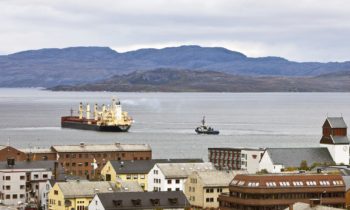 The area above the Arctic Circle is finally getting some attention from western politicians, after Barack Obama’s presidential trip to Alaska and a global climate change conference there. Sure, any jolt of activity is likely a welcome occurrence in these far northern communities, but barring sparse high-profile visits, towns and villages in the Arctic nurture and cultivate local economies on their own.A 60-kilometer wide no-visa zone in the Barents Region, halfway across the Arctic Circle from Alaska, is one tool that locals use to spur economic activity. Spanning both sides of the Norwegian-Russian border, this no-visa zone exists to fuel business collaborations and regional trade there.
The area above the Arctic Circle is finally getting some attention from western politicians, after Barack Obama’s presidential trip to Alaska and a global climate change conference there. Sure, any jolt of activity is likely a welcome occurrence in these far northern communities, but barring sparse high-profile visits, towns and villages in the Arctic nurture and cultivate local economies on their own.A 60-kilometer wide no-visa zone in the Barents Region, halfway across the Arctic Circle from Alaska, is one tool that locals use to spur economic activity. Spanning both sides of the Norwegian-Russian border, this no-visa zone exists to fuel business collaborations and regional trade there.
The border between Norway and Russia runs 196 kilometers (122 miles) from Finland north to the Barents Sea. On the Norwegian side of the border, the no-visa zone extends 30 kilometers northwest, including the mining town of Kirkenes. On the Russian side, the no-visa zone extends 30 kilometers southeast, encompassing the mining town Nikel. At certain points on the Russian side, the zone even extends further, up to 50 kilometers from the border.
Russian or Norwegian citizens who have lived for three years within this range can buy a €20 ($22.40) permit to travel freely within the whole no-visa area. The permit is valid for three years and allows the holder to stay in the neighboring country for up to 15 days at a time. All travelers must pass through the sole official checkpoint in Storskog, Norway. A more traditional multiple-entry visa costs €35.
Kirkenes and Nikel, both above the Arctic Circle, were once wholly dependent on mining iron and nickel. After the Soviet Union collapsed, local interest grew in developing commercial activity there. The Norwegian and Russian governments eventually established the no-visa zone in 2012 in order to encourage trade across their borders.
“You might think that the locals do a lot of cross-border activity, but it’s not that much. A lot of people from Kirkenes have never been to Russia, and a lot of people in Russia have never been to Kirkenes,” says Hilde Methi, a Kirkenes-based independent art curator. Nevertheless, she says, some cultural and business collaborations go on between Nikel and Kirkenes, beyond the mining. And there’s certainly more people-to-people contact and even international marriages. “Russians come to Norway to go shopping,” she says. “And Norwegians go to Russia to get cheap fuel and petrol.”
Everywhere in the visa-free zone is a shared dark side, too: the growing threat to the region posed by environmental destruction and heavy pollution from local ore mining and petroleum operations in the Barents Sea.
Says Methi, “You see this really polluted part [in Russia] that has a huge impact on the vegetation and soil. The trees are dead.” Mining activities in Kirkenes also perturb the Norwegian side of the border. As in the rest of the Arctic, climate change is contributing strongly to the decline of the environment near Kirkenes and Nikel.
Temperatures are rising twice as fast there than the global warming average below the Arctic Circle, and scientific evidence points to the effects: rising sea levels, flooding, and extreme weather.
(qZ)
